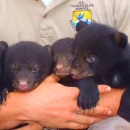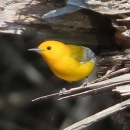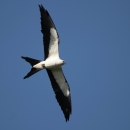Seasons of Wildlife
Spring migration brings the color and song of neotropical migratory birds to the bottomland hardwood forests and wetlands in the Refuge. Visit in April or May for the best birding.
Featured Species
Some wildlife species need large blocks of habitat to support their needs and assure healthy populations. As land is converted to agriculture and development, connectivity between habitats is reduced, making it more difficult to maintain wildlife populations. The refuge’s wetlands and forests of oak, elm, and hickory support many native species that have declined as a result of habitat fragmentation, including the Louisiana black bear; the Swainson's, northern parula and prothonotary warbler; swallow-tailed kite; and wood thrush. The Atchafalaya Basin supports one of the three core populations of Louisiana black bears in the state. The Refuge provides an area of large, contiguous bottomland hardwood forest that is good habitat for this species. Louisiana black bears will travel through marshes, spoil banks along bayous, and even agricultural fields.
Neotropical Songbirds
With over 200 different species of birds documented on the refuge, Atchafalaya National Wildlife Refuge is great stop for a birder. Spring and fall bring an array of color, with neotropical bird populations traveling between their breeding and wintering grounds. Listen for the secretive Swainson's warbler singing from a thicket, or watch for brilliant flash of color of a prothonotary warbler or a painted bunting. If you are lucky, you may see the distinctive swallow-tailed kite soaring and hovering gracefully in the sky — look for the distinctive black wingtips, forked tail and white head, shoulders, and abdomen. This striking and rare raptor nests on the refuge and is considered one of the most threatened land birds currently without federal protection. The Atchafalaya is a major bird corridor for fall and spring hemispheric migrations and the refuge has been noted as a Globally Important Bird Area by the American Bird Conservancy.
Refuge for Interior Forest Breeding Birds
Due to forest fragmentation, brown-headed cowbirds (a seed-eating bird common in agricultural areas) are now closer to the natural nesting sites of many forest interior nesting birds. The brown-headed cowbird is a nest parasite that lays eggs in the nests of other birds, rather than building a nest of its own. Because the cowbirds are larger and more aggressive, they typically out compete host birds. This results in poor reproductive success and declining populations of forest interior-nesting species.
The Atchafalaya Basin provides a “source” population of interior forest breeding birds through reproduction as opposed to many bottomland hardwood areas being a “sink” population. A source population is one where the reproduction capability of these forest interior birds is higher than the predation and parasitism that occurs in that area, whereby a sink population is one where reproductive success is less than losses from predation or parasitism. Atchafalaya NWR is part of this source population. Keeping habitats intact helps to maintain the area as a source for forest interior bird reproduction.






